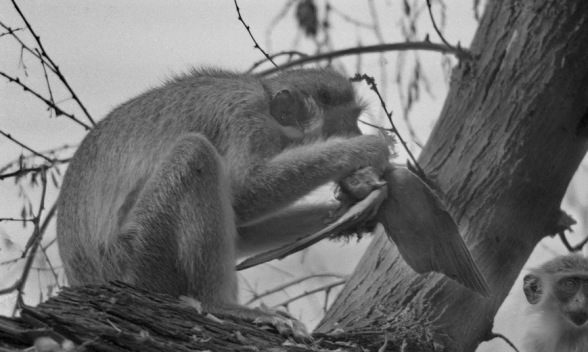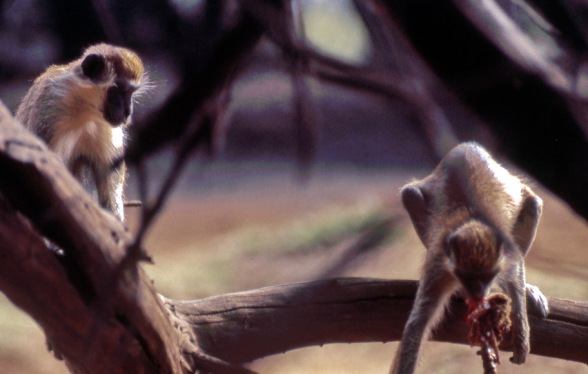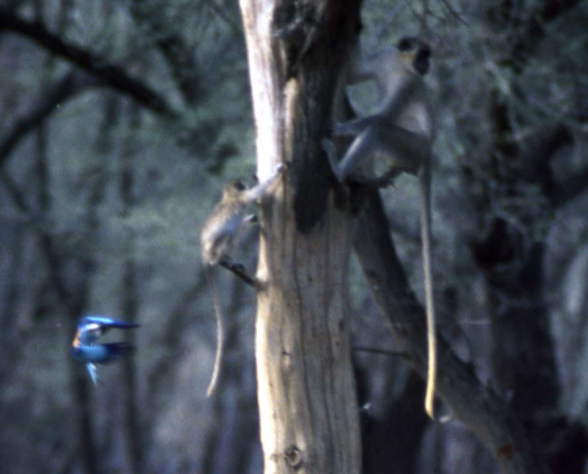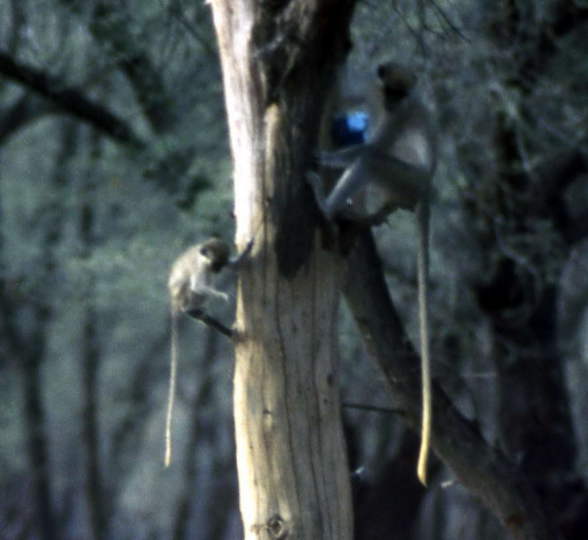Singe vert, Callitriche et proies - Page 3
-Vallée du fleuve Sénégal, Niokolo Koba
-Green Monkeys-snakes interactions records at the bottom of the page
Voir aussi Page 1 : Burkina Faso ; Page 2 : Sénégal vallée du fleuve; Page 4 : Sénégal Saloum avec Guib harnaché, Colobe bai et Phacochères, en mangrove, mangent crabes (à notre connaissance, les premières images); in the Saloum mangrove, they eat crabs ;
Modifications et ajout d'images en cours. Nous laissons la page accessible pendant sa réorganisation. Merci pour votre indulgence.
Reproduction soumise à l'autorisation des auteurs ou des ayant droit
Sénégal vallée du fleuve Sénégal
Singes verts et tourterelles vineuses Streptopelia vinacea
La chasse aux criquets. Illustration Luong Thanh Minh.
© Gérard Galat & Anh Galat-Luong
Vidéos :
Chasse aux criquets #099536 © Gérard Galat-IRD 1988
Chasse aux criquets #099555 © Gérard Galat-IRD 1988
Singes verts et chèvres, zébus, phacochères, serpent, ombrette
Vidéos :
et zébus vocalisations #020297 © Gérard Galat-IRD 1995
et zébus vocalisations #020296 © Gérard Galat-IRD 1995
près d'une Ombrette qui collecte de matériaux pour son nid
Sénégal parc national du Niokolo Koba
Green Monkeys-snakes interactions records
- 1976, Senegal. Young green monkeys played (pulling the tail) with colubrid grass-snakes (not Naja) under their mother’s field of view, without showing the least fear reaction, neither by the young, nor by the mother or other adults.
Citation: Galat G., Galat-Luong A., Luong T.M., Nizinski G. 2011. Le journal intime d’un Singe vert face au changement climatique. JePublie. Arcueil. pdf 48p. ISBN 2951053436.
Precisely, in this book, we let our “monkey hero” (a green monkey Chlorocebus sabaeus) “say”, summarizing our observations:
(Google translation from French) “Hazard gradation
I learned to discriminate between several categories of predators, whether they are terrestrial or aerial, dangerous for all or only for the youngest, hunters who need to be outdistanced, hunters on the lookout that to reveal with cries for them to go away, their strategy rendered obsolete. I also know how to recognize the different dogs individually in the neighbourhood and adjust my safety distance to their individual peculiarities: I warn the mothers with children of the arrival of the snarling mastiff, but I am content to push me a few meters in front of the lame old one. When a child plays with a snake, I let it go. The little ones always try to play; it is a way of learning, the other being to imitate those who know. If it had been a poisonous snake, I would have raised the appropriate alarm that would have dissuaded the youngster from pulling the tail of the animal at the same time as I would have instructed the other members of the presence of a dangerous terrestrial animal that should be harassed in a group to make it clear.”
- 1976, Senegal. Contagious alarm chutters and threat alarm like barks as green monkeys Chlorocebus sabaeus detected Naja senegalensis snakes (on the Senegal river bank, much further north than the IUCN map). These vocalizations where specific of ground slow predators hunting on the lookout. In one case, as usual, Gerard was followed by a specific adult female we named “Bou” (Anh was also usually followed by a specific adult male). Seeing a Naja straightened in defensive display, Gerard stopped, freezing. Noticing Gerard’s behaviour, “Bou” stood on his hind legs, noticed the snake, and emitted a call souding like a chutter and like a high-pitched threat alarm call. Some of the other monkeys of the troop checked in our direction, but continued on their way. None came to check what happens.
Publication
Adie, F, Galat-Luong, A, Galat, G 1997. Les grands Mammifères du Niokolo-Badiar. FED No 4213/REG & Anh Galat-Luong Eds. Belancor, Rueil-Malmaison. 100p. ISBN 2-9510534-1-X. Recommandé par Lonely Planet West Africa Guide 1999.
Illustrations Luong Tanh Minh Epuisé. [Télécharger pdf]































































